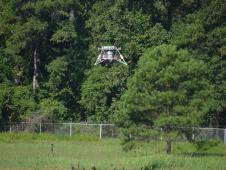By Kalwinder KaurAug 18 2012
During a 32-second free flight, NASA's "Mighty Eagle" identified its target on August 16 at NASA's Marshall Space Flight Center in Huntsville, Alabama. This compact robotic lander prototype practically represents technologies that can be used for the final arrival of an autonomous controlled landing on asteroids, moon, or other celestial bodies.
 NASA's 'Mighty Eagle' Robotic Prototype Lander Finds Its Target
NASA's 'Mighty Eagle' Robotic Prototype Lander Finds Its Target
Driven by 90% pure hydrogen peroxide that acts as fuel, the three-legged "green" lander is being commanded from an onboard computer that stimulates the onboard thrusters to take it to a controlled landing. This versatile lander measures 4 ft in height and 8 ft in diameter. Its weight is 700-lb when fueled. The test forms a part of a new series of free flights that focus on testing the autonomous rendezvous and capture capabilities of the vehicle with the help of an on-board camera for optical navigation to a landing site and destination area.
The vehicle was lifted to an altitude of 30 ft by the recent flight. Within that specific location, the vehicle was recognized as an optical target painted on the ground beyond 21 ft and lowered down for a safe landing.
NASA's "Mighty Eagle" will foster the maturation of technology, based on creating advanced smart, economical, versatile robotic landers that can complete scientific and exploration objectives across the solar system.
Around 25 test flights were successfully completed by the team during 2011- 2012, fulfilling all test objectives. Earlier tests verified the reusable robotic lander exercised flight, flight design, and design team partnerships integrating novel off-the-shelf flight components. Also, guidance, navigation and control algorithms were represented.
Following the achievement of its original mission, the vehicle is considered as a functional aerial test platform accommodating the demonstration of new algorithms and flight sensors. Additional free flights that can soar up to 100 ft altitude are scheduled for September end.
The Marshall Center and Johns Hopkins University Applied Physics Laboratory in Laurel developed "Mighty Eagle" prototype lander for NASA HQ Planetary Science Division, Science Mission Directorate.
Disclaimer: The views expressed here are those of the author expressed in their private capacity and do not necessarily represent the views of AZoM.com Limited T/A AZoNetwork the owner and operator of this website. This disclaimer forms part of the Terms and conditions of use of this website.